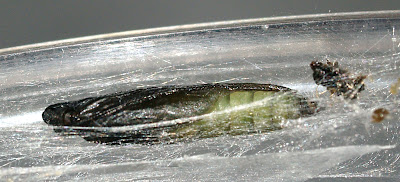 |
| Parry's Penstemon on the left, pink flowers |
 |
| 5th instar caterpillar, leaf-cradle pulled apart |
On February 28th one of the caterpillars had pupated in a loose mesh of silk on the rim of the container and I thought the other one might have been killed by the fungus that eventually enveloped the collected plant tissue. I was wrong, I found another adult moth on the ceiling of my studio today.
 |
| Antigastra catalaunalis |
His Id lead to more information: The little moth in the family Crambidae (Crambid Snout Moths) » Subfamily Pyraustinae » Tribe Spilomelini » Genus Antigastra is called Antigastra catalaunalis (Sesame Leafroller Moth - Hodges#5181). It is an introduced species that is now widespread in tropical and subtropical regions of the world. In the US it is found from Southern Arizona to the eastern Mojave Desert and north to the northern areas of Utah.
 |
| Indian Insect Life: a Manual of the Insects of the Plains by Harold Maxwell-Lefroy. |
A research paper from India studying the moth's life cycle on Sesame as the host plant finds that warm temperatures and low rainfall and humidity favor population explosions of the moth. Those are conditions that it will find here in Arizona.
In October of 2012, Carl Olson (duh, I could have just asked my friend and collegue right away!) found that reports were flooding in about unusual damage to landscape plants, such as Tecoma stans (yellow bells) and Tecoma alata (orange jubilee). Dark larval droppings, webbing and a loss of green leaf tissue were the obvious signs and symptoms of activity by the leaf-tier caterpillar, Antigastra catalaunalis. He suggested that since the caterpillars were tightly rolled up in leaves they were protected from most predators and contact pesticides but might be controlled using high doses of products based on Bacillus thuringiensis.
Since to our knowledge the moth hasn't been in Arizona for long, not much is known about its life cycle here, but I can now say that there is at least an early spring (Penstemon) and a summer (Tecoma) generation. These plants in the families Scrophulariaceae and Bigoniaceae and common in the wild as well as in landscaping around Pima ad Maricopa County. The landscaping plants, being grown in high concentrations and often under sub-optimal conditions, will probably suffer more than their wild relatives. I imagine that the population of the species might shoot up to an initial peak as many introduced species do, but then decline gain as diseases and predator populations catch up.
In 2012 Carl Olson speculated that these immigrants may not be able to survive our occasional cold winters (the winter of 2011/12 had been very mild). But my early collection date, right after the very heavy freeze of 2013 (Jan 13 to 16), indicates that the moth (its eggs?) might be rather freeze tolerant.
 |
| Penstemon parryi and Pipevine Swallowtail (Watercolor by M.Brummermann) |




Fascinating story as usual! When I saw your painting in my peripheral vision I thought it was a photo! So vibrant!
ReplyDeleteI love your painting, it's beautiful!
ReplyDeleteGorgeous painting. I love the background particularly. Don't take that the wrong way! It's so clever the way it's blurry.
ReplyDeleteI also love your painting. The colors are fabulous and it would look great hanging on one of my walls!
ReplyDelete